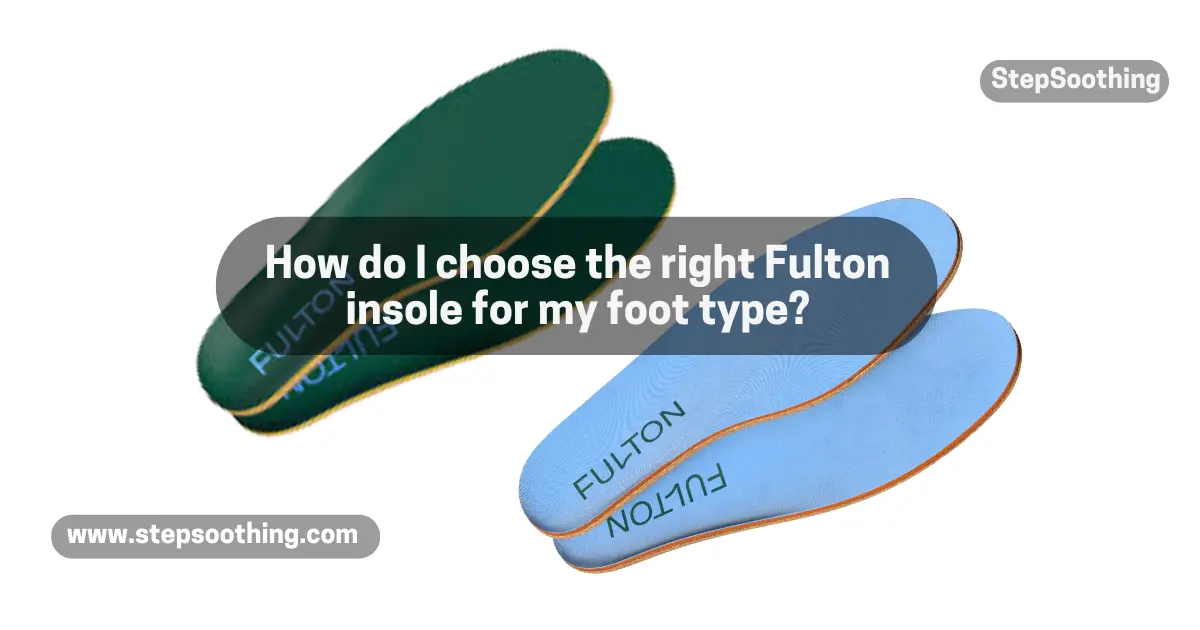Choosing the right Fulton Insole for your foot type can improve comfort, reduce pain, and support better posture. Whether you have flat feet, high arches, or a neutral arch, Fulton insoles offer models tailored to your biomechanical needs using sustainable materials. This guide breaks down which insole works best for you based on foot type, gait, and activity level.

What Foot Types Are Supported by Fulton Insoles?
Fulton insoles support the three primary foot types:
- Neutral arches → Standard support with moderate curvature.
- High arches → Elevated arch support with better cushioning.
- Flat feet → Require low-arch structure with extra stability and motion control.
While Fulton insoles are designed for general use, your gait pattern and arch height play a key role in choosing the ideal model.
What Are the Main Fulton Insole Models?
Fulton offers two versatile models crafted from natural cork, vegan leather, and cotton:
| Insole Model | Best For | Key Features |
|---|---|---|
| Fulton Classic | Casual wear, office use | Medium arch support, cork base, deep heel cradle |
| Fulton Athletic | Sports, long walks, high-impact use | Firm arch support, shock-absorbing heel, structure |
Both models mold over time for a semi-custom fit.
Which Fulton Insole Is Best for Flat Feet?
Flat feet need maximum stability and motion control.
Choose:
- Fulton Athletic
Why:
- Deep heel cup improves alignment.
- Cork base stabilizes overpronation.
- Foam layer supports plantar fascia.
Which Fulton Insole Is Best for High Arches?
High arches increase pressure on the forefoot and heel.
Choose:
- Classic for light use
- Athletic for sports or standing long hours
Why:
- Cork contours to high arches
- Extra heel padding improves shock absorption
- Cushioned forefoot supports metatarsals
Which Insole Should I Pick for a Neutral Arch?
Neutral arches need balanced support—not correction.
Choose:
- Classic for daily wear
- Athletic if walking long distances
Why:
- Moderate arch height suits your natural shape
- Material adapts without overcompensating gait

How Do I Measure My Arch Type?
Use the wet footprint test to identify your arch type:
- Wet your foot and step on a paper bag.
- Observe the print pattern.
| Arch Type | Footprint Appearance |
|---|---|
| Flat Foot | Full imprint with no visible arch curve |
| Neutral Arch | Defined curve on the inner side |
| High Arch | Thin line between heel and forefoot |
This simple method helps you choose the right support.
How Does Gait Affect Insole Choice?
Your gait how your feet move when walking changes how weight and pressure spread across your feet. If your foot turns inward too much (overpronation), you need better control and firm support. The Fulton Athletic model is ideal for this. If your foot rolls outward (underpronation), a more flexible and soft insole like the Fulton Classic is a better match. For a neutral gait, your choice depends on how much walking or activity you do. To be sure, a gait analysis from a foot expert or running store can guide your decision.
Can I Use Fulton Insoles in All Shoes?
Yes, but shoe compatibility depends on style and space:
| Shoe Type | Best Insole | Notes |
|---|---|---|
| Sneakers | Fulton Athletic | Great for workouts |
| Dress Shoes | Fulton Classic | Slimmer fit, discreet |
| Boots | Either | Based on usage level |
| Sandals | Not Compatible | Requires closed shoes |
Ensure the insole does not crowd your shoe’s toe box.
Do Fulton Insoles Come in Different Sizes?
Yes. Fulton insoles are available in trim-to-fit unisex sizes, making it easy to find your match. Men’s sizes range from 4 to 14, and women’s sizes from 6 to 15.5. To get the right fit, use a ruler to compare your current insole or foot length with Fulton’s online sizing chart. Each insole can be trimmed from the toe end to ensure a perfect fit in your shoe.
Are Fulton Insoles Custom-Molded?
Not exactly. Fulton insoles are semi-custom, which means they adjust to your feet over time but are not made specifically for you. The natural cork material starts to mold to your foot shape after about 10 to 15 wears, using the heat and pressure from walking. This gives you a more personal and comfortable fit—without the high cost of fully custom orthotics.
When Should I Replace My Fulton Insoles?
Replace based on wear and activity:
| Usage Level | Replacement Interval |
|---|---|
| Daily walking | 6–9 months |
| Sports/training | 3–5 months |
| Occasional use | Up to 12 months |
Signs to replace:
- Flattened arch
- Heel cup collapse
- Foot fatigue increase
What Are Fulton Insoles Made From?
Fulton insoles are made from eco-friendly and non-toxic materials. The natural cork core absorbs shock and molds to your foot shape. Latex foam adds softness for extra comfort. A top layer of vegan leather makes the insole tough and long-lasting. Underneath, cotton canvas lets air pass through to keep your feet cool. These parts work together to give you support, comfort, and sustainability.
Can Fulton Replace Medical Orthotics?
No. They’re not substitutes for custom orthotics:
| Feature | Fulton Insoles | Custom Orthotics |
|---|---|---|
| Support Level | Moderate | High, Condition-Based |
| Customization | Molds Over Time | Scan-Based Molding |
| Cost | $48 | $200–$800 |
| Lifespan | 6–12 Months | 1–3 Years |
Use orthotics if you have:
- Severe overpronation
- Diabetes foot issues
- Plantar fasciitis
- Foot deformities
Can Fulton Insoles Help with Plantar Fasciitis?
Yes, for mild symptoms. Fulton insoles support your arch and heel, which helps ease pain. The cork base absorbs shock and reduces pressure on sore spots. They also help spread your weight evenly across the foot. But if the pain is long-lasting or severe, it’s best to see a podiatrist for a proper diagnosis.
Who Needs Custom Orthotics?
Some foot conditions require more specialized care than what regular insoles can offer. Custom orthotics are often necessary for rigid flat feet (pes planus), high arches (cavus foot), or posterior tibial tendon dysfunction. People with neuropathy, arthritis, or forefoot pressure problems such as metatarsalgia may also need custom orthotics. These conditions need medical-grade support. Fulton insoles are helpful for everyday comfort, but they are not designed for medical correction.
How Durable Are Fulton Insoles?
Durability varies with activity:
| Activity Type | Fulton Lifespan | Orthotics Lifespan |
|---|---|---|
| Office work | 9–12 months | 2–3 years |
| Daily walking | 6–9 months | 1–2 years |
| Intense training | 3–6 months | 1 year |
Check cork compression and arch integrity often.
Conclusion:
When choosing Fulton insoles for your foot type, consider your arch structure, gait, and shoe type. These sustainable insoles made from cork and vegan leather adapt naturally to your feet, offering semi-custom comfort and orthopedic support. If you need more specialized correction, custom orthotics may be a better fit. For most users, however, Fulton insole materials strike the right balance between comfort, function, and eco-conscious design.



